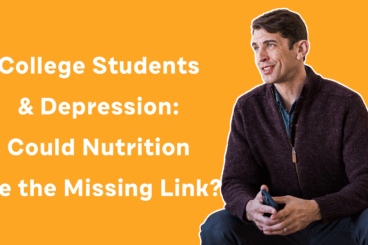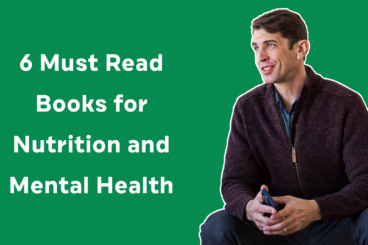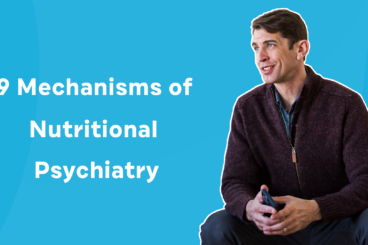How to feed your mental health on a budget? That is such an important question right now. We’ve created an ebook, Brain Food on a Budget, that our team has developed to help you. I’m Dr. Drew Ramsey. I’m a nutritional psychiatrist and I wanted to come on and give you four or five of the most important points and food categories and some of our tips on how you can get those foods and all the nutrients they have for your mental health and still save money.
Now everyone, what is nutritional psychiatry? This is how we think about nutrition and our food choices based on the most recent research on how nutrition impacts mental health, particularly things like our risk of depression and anxiety. So let’s talk about brain food on a budget. Now in my version of nutritional psychiatry, we talk about food categories. So it’s not just trying to get you to eat more kale and more wild salmon, but thinking about what do those food categories represent?
So I have a little rhyme to help you think about your next meal and nutritional psychiatry: seafood, greens, nuts and beans, and a little dark chocolate, rainbow celebrations, don’t forget the fermentations. Now we’re going to go through those food categories with budget in mind because it’s so important these days with food prices skyrocketing and more people feeling food insecurity, that we really know that our money is going as far as it can to take care of our brain health and our mental health. And again, more than ever, we know nutrition is one of the biggest decisions we make.
Seafood
Let’s talk about seafood and how to get that on a budget. Now, a lot of folks have great tips, but I’d say my top one is tinned fish or fish that is frozen. First of all, when you’re talking about fresh fish in the grocery store, it’s always been frozen and then defrosted for you. You can skip that step, save some money, get a few pounds of something like wild salmon and keep it in the freezer. It’s always a great quick meal and you don’t have to worry about freshness.
My favorite tip though is tinned fish because in nutritional psychiatry, we’re really looking for those fish that have a lot of omega-3 fats, but we don’t need to worry as much about things like mercury or microplastics. And we do that by finding smaller, younger fish. So taking an anchovy and learning to make a real caesar salad or sardines in pasta con sarde, one of my favorite recipes. You can learn a lot about how to use seafood and can have to save money with tips like this with our resource, Brain Food on a Budget. Scroll down to the end of this blog post to get your copy of it.
Leafy Greens
All right, next food category is leafy greens. Wow nutrient density, right? 20 to 35 calories per cup of greens and you’re getting more than 100% of your daily need of vitamin C, vitamin A, vitamin K, folate and fiber. You’re getting these phytonutrients for these incredible molecules that plants bring to the table, and they really protect our health. I’ve got a lot of interesting videos up about phytonutrients particularly some of the purple ones called anthocyanins. So please check that out for more detailed information.
Leafy greens are also always bringing fiber. And anytime we’re eating for our mental health, we’re thinking about fiber because most people aren’t getting enough fiber. And that helps feed our microbiome. Again, lots of information I’ve got about the microbiome up on my website and the new exciting science of how that impacts your mental health.
How do you save money on greens? So farmers markets are a great place to get good value. I really like frozen greens and frozen vegetables, things like frozen broccoli, frozen kale. Greens are really easy to grow during the fall and summer months and even in spring. If you have a little backyard and you like gardening, it is really easy to grow some greens for yourself. So those are some of the tips that I have for leafy greens. Again, great food category, usually very inexpensive and very filling. Seafood, greens, nuts, and beans.
Nuts and Beans
Let’s talk about nuts and beans. These are one of my favorite food categories when you’re on a budget because they just bring so much nutrition to the table. The fats in nuts is the same fat as olive oil, which has lots of minerals like magnesium, and then some special nutrients like vitamin E in almonds. I want you looking for unsalted, unroasted nuts, called raw nuts. The reason for that is one, the salt always just keeps you eating more nuts and nuts are a more high calorie food. So we want to be judicious with their use. Also, when you’re roasting nuts, you can smell the bag and you can tell whether they’re fresh or not. You really want to make sure they are not rancid and have not spoiled. Look for them on sale because nuts store really well in the fridge, for example. So looking for those deals and buy a pound or two pounds at a time of raw and unsalted nuts.
Now beans, wow, this is one of the best categories for a budget because you can get dried beans for an incredible value. You can eat for weeks on a couple pounds of dried red beans, dried black beans. For me, the quick kind of everyday value of canned beans, I find a really nice price point sometimes 99 cents or $2 for a can of beans. This adds protein and fiber. It has all these great phytonutrients, whether you’ve got the purple ones or black beans. There is lots of potassium in white beans. So again, this idea is you’re eating different types of beans or types of nuts and getting that diversity in plants in our diet is huge for eating your mental for your mental health. And a great way to think about your budget because it allows you to kind of look in the grocery store and get some of these bulk items that are on sale. Those are some ideas for nuts and beans.
Dark Chocolate
A little dark chocolate. It’s more than a tasty treat. Dark chocolate is a plant-based food. It comes from cacao. It’s fermented; it has magnesium, iron, and fiber. These are some of the most important nutrients for our mental health. The problem is so many people are eating dark chocolate that’s really expensive and it’s like a confection or candy as opposed to really looking for a high cacao content in a dark chocolate bar, 70%+. You want to look for a brand that is saying they don’t have lead or cadmium. There’s a big concern about that.
I recommend people go with the original. There’s great value in just cacao beans or in cocoa because you’re getting the essence of dark chocolate and you can add in the sweetener. A lot of times in my home for dark chocolate and chocolate based things, we use a little cocoa powder or cacao nibs and we use a banana as a sweetener. So again, great value that you can find in not buying the candy, buying the expensive chocolate bars, but making your own dark chocolate by combining cacao with a sweetener of choice.
Rainbow Celebrations
Rainbow celebrations, what do we mean? Look at your plate. I want to see an art project. I want to see all kinds of different colors, reds and purples and yellows. Why? Because different colors mean different phytonutrients. I’ve got lots of great information on my website about phytonutrients and why colorful plants are so important for your mental health. Part of it is that they adjust and tune the microbiome, meaning that they help us have a microbiome that is more trending towards decreasing inflammation. Another reason different colors are so important is it means we’re bringing different nutrients and different phytonutrients to our plate without really needing to count anything. I always encourage myself and I’m going to encourage you add another color.
Now, how does this save money? Well, it allows you look at your fridge and think about adding different ingredients, different pieces and adding to what’s both a beautiful plate on Instagram, but also allows you to have the most nutrient density on a budget. You’re adding a little bit of carrot, a little red pepper, a little red onion, right? And you’re getting something that’s both much more beautiful but also has a larger diversity of nutrients for you and for your health.
Fermentations
Don’t forget the fermentations. How could we forget the fermentations these days with all the incredible microbiome science coming out? Because that’s what fermented foods are all about. Lots of information up on my site about this because microbiome science is so interesting and it’s new. Eating fermented foods, which are foods that have live bacteria in them, things like kefir, yogurt, miso, kimchi, sauerkraut, means that we’re adding and modifying the types of bacteria that live in our gut, mainly in our colon. Now that’s wild. How does that relate to our mental health and brain health? And how does that to do with a budget?
Regulating inflammation and this gut brain access is where the science is headed. And it’s a powerful lever that you have to influence your health and your mental health. More fermented foods are also great on a budget because you just need a little bit at a time. You can buy a big container of kefir. You’re going to have more what’s called colony forming units. That’s what you see on the probiotic pills. You’re have more colony forming units in a serving of kefir than anything else in the grocery store. Seriously, like up to a trillion colony forming units. So this is where fermented foods are of great value. Don’t waste your money on probiotics. Spend your money on fermented foods.
Even better on the budget, you can make your own. To make sauerkraut, all you need is salt, a cabbage, a jar and a little instruction. We have always had fermented foods because it’s the original way we preserved foods. So this is really one of the original health foods. Try to get more fermented foods in your diet.
Thanks so much for watching everybody. Those are some ideas on how to get more nutrition on a budget. It’s really important. Food security is one of those things that’s actually just critical to your mental health. Getting nutrient density these days and having your food dollar really work for you to feed your mental health. That’s what we’re all about in nutritional psychiatry. If you like this video, please share it with someone who maybe needs a little help with their budget, their food and their mental health.
Please subscribe for our free newsletter comes out every Friday to help you keep taking care of your mental health and building your mental fitness. I’m Dr. Drew Ramsey, everybody. Great to see you. I’ll see you in the next video.



